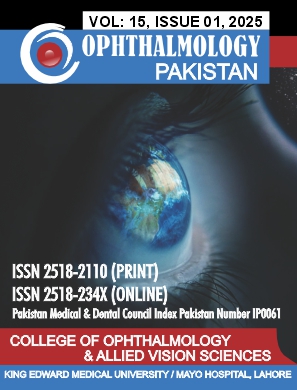Conjunctival impression cytology used as a gold standard test in evaluating the cases of Computer Vision Syndrome among young university students
DOI:
https://doi.org/10.62276/OphthalmolPak.15.01.181Keywords:
Video Device Terminal, Computer Vision Syndrome, Dry Eye Disease Questionnaire, Conjunctival Impression Cytology, Tear Function TestsAbstract
Objective: To find the correlation between clinical dry eye tests and conjunctival impression cytology examination for the assessment of computer vision syndrome in university students in Lahore.
Methodology: An analytical cross-sectional study was conducted on 225 students at the University of the Punjab. A questionnaire-based data was collected, followed by measurement of tear-film breakup time (TBUT), the number of corneal dry spots& Schirmer’s test, and conjunctival impression cytology (CIC) under topical anesthesia. Pearson correlation analysis was done on CIC score versus TBUT, Schirmer’s test, and Goblet Cell Density (GCD). Analysis of variance (ANOVA) was used to compare visual acuity, TBUT, cornea spots, and Schirmer’s test to see the significance of the results. A p-value ≤0.05 was considered statistically significant.
Results: Out of the 225 students, 63 % were females compared to 37% male students. The mean age of the students was 19 ± 3.8 years. There was a statistically significant mean difference found between the CIC score and TBUT (F=208.45p=<0.001), cornea spot (F=39.31, p=<0.001), and Schirmer’s test (F=5.83, p=0.001).
Conclusion: In addition to applying the validated questionnaire and clinical dry eye tests, Conjunctival impression cytology should be tested on larger populations for the early diagnosis and management of CVS to be proven as a gold-standard test.






